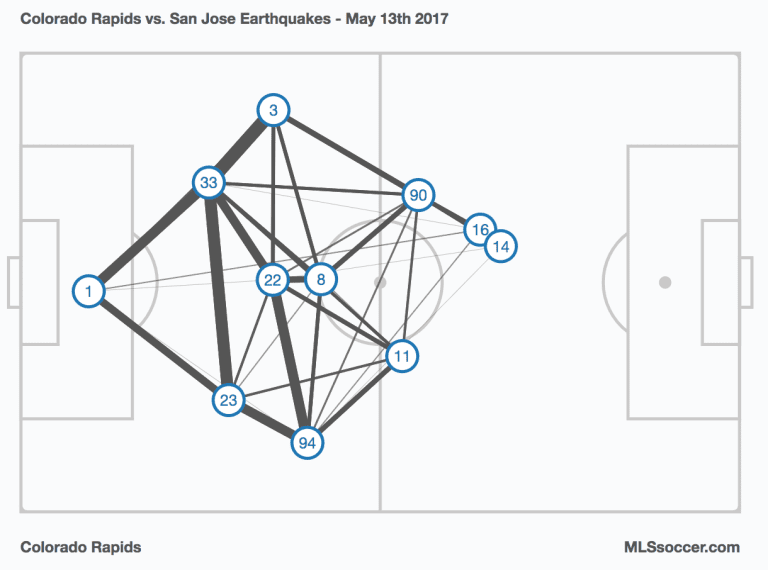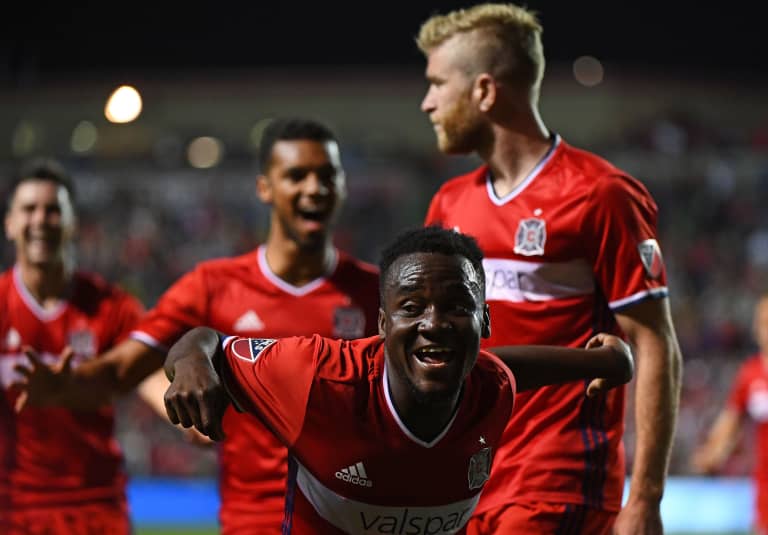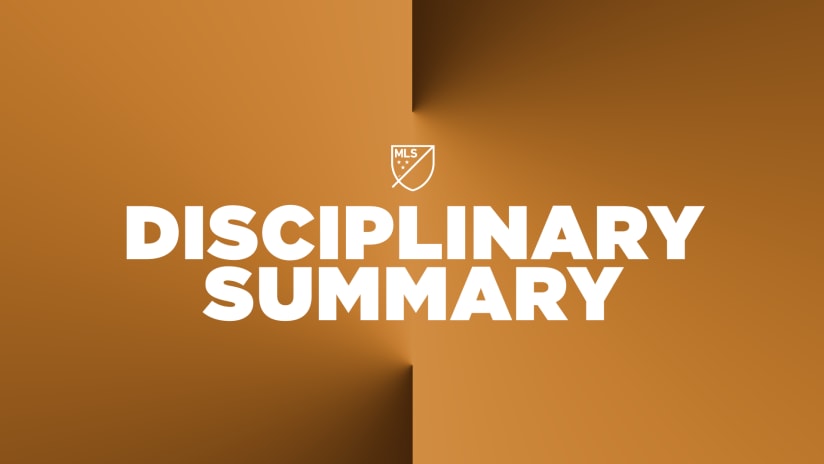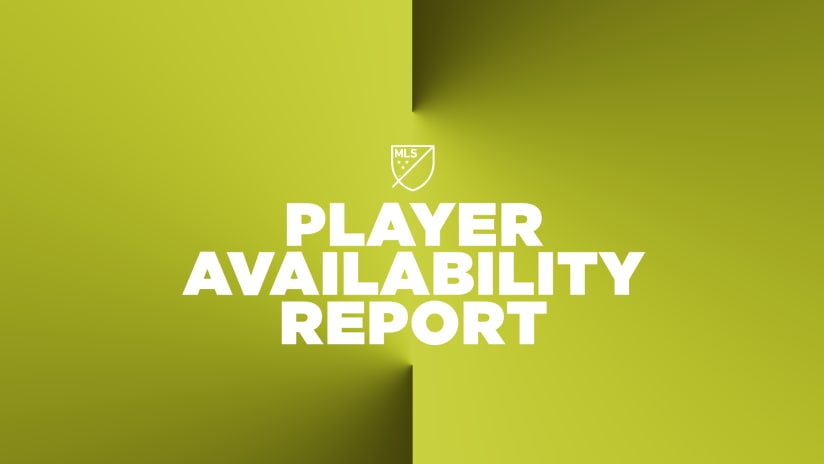Week 11 saw Eastern Conference teams go 3-1-3 against the West. It feels a lot like the balance of power has at the very least evened out, if not outright shifted entirely east of the Mississippi.
If that's the case it would be the first time since 2008 that the Eastern Conference was the stronger one. There's still too much of the season yet to be unfurled to be overly confident or make any absolute predictions, but we've seen enough to know that some shift has, indeed, occurred.
Let's start with the outlier:
Get It Together
The New York Red Bulls took a risk this winter, gambling away some short-term pain in hopes of long-term gain. They have been rewarded with ups and punished with downs and have often looked only like a facsimile of the team that won the Supporters' Shield in 2015 and came close to making it two on the trot in 2016.
On Sunday, they came up well short in their 3-1 home loss to the Galaxy, their first regular season loss at Red Bull Arena since April 9 of last season. The Galaxy, who played a very simple, very straight-forward 4-4-2 with both central midfielders staying home, looked the best they have all year Veteran center back Jelle Van Damme took last week's benching like a champ and cut out the high-risk play that'd been killing his team all season, and the central midfield combination of Baggio Husidic and Joao Pedro was solid in a way previous iterations of LA's central midfield hadn't been, and Romain Alessandrini continues to be one of the best acquisitions of the season.
But as relieved as the Galaxy are to put together two straight quality halves of soccer for the first time in 2017, the story from Harrison feels more like it's about the hosts. This game was – in Jesse Marsch's words – "The worst performance since I've been here at Red Bull at home, for sure."
RBNY have three big problems:
- Their wingers lack speed, which allows opponents to compress the field
- Aurelien Collin's physical and steady presence has been missed in the center defense
- Sacha Kljestan is getting on the ball deeper, and in less dangerous spots, than in the past two years
That last issue is tied pretty tightly to the Dax McCarty trade, which was the big offseason gamble I talked about. McCarty is missed for the defensive bite he added and for his surprising facility on set pieces, but more than anything it was his ability to get the ball to Kljestan in the best spots that defined this team over the previous two years.
It's not happening like that in 2017. Fully 55 percent of Kljestan's pass attempts were in the attacking third last season, when he became just the second player in league history to his 20 or more assists. That's dropped to 46 percent this year, and continues to fall as of Sunday.
McCarty specialized in drawing defenders to him, then hitting third-line passes to split them:
The idea is to take an extra beat and draw the defense upfield a bit, then cut them both out of the play with one touch. "Wait for Sacha to find space, then find him" was how New York played last season, while this season feels more like "let's just find Sacha." It's rushed.
Kljestan himself is perhaps playing into this with a bit of positional indiscipline and a lack of patience, which explains why he's drifting deeper and deeper. He doesn't seem to trust either Tyler Adams or Sean Davis the way he trusted McCarty, which is entirely understandable. But it's still at least a little bit jarring to see New York so disjointed when playing from back to front, and unable to establish their tempo to any degree.
This is very much the "short-term pain" part of this winter's gamble. The key now is to get in the film room and dissect what's happening, and make sure that this pain is, indeed, only short term.
Hold It Now, Hit It
Orlando City have played six of their 10 games at home. They've won five of those and, on Saturday, finally dropped points at their glorious new stadium as Sporting KC came into town and left with a point. The 2-2 draw against Sporting marked the first time they've dropped points at their stadium.
It also marked, perhaps, a turning point for Gerso and SKC as a whole (volume up for analysis):
Armchair Analyst: Gerso has become more decisive and direct, and it's starting to pay off for SKC with goals pic.twitter.com/HiEN01LM6y
— Matthew Doyle (@MattDoyle76) May 14, 2017
Gerso has stopped holding play up before putting defenders on the back foot. Over his first two months he was mostly content to receive the ball, let the defense reset, then try to attack. It's like he was only comfortable going against a set defense rather than pushing the issue while his opponents were scrambling.
That looks to have changed more than a little over the last three weeks. If SKC start getting this kind of penetration from their wingers and that kind of finishing from Latif Blessing, they will spend the vast majority of 2017 in the hunt for the Supporters' Shield at the very least.
The above remains a huge "if," of course. Gerso's not yet a known quality and it's not clear that Blessing's goals will be additive – he got them both this weekend while playing as a center forward, which is a job he won't be wrestling from Dom Dwyer (who missed the OCSC game with a yellow card accumulation suspension) any time soon.
Don't get me wrong: It's good to have a back-up forward who can get goals, and SKC fans should be happy Blessing seems to be that guy. But in order for SKC to jump up into the ranks of the league's elite, they still need to figure out how to get goals from a winger.
The New Style
Injury and suspension and underperformance necessitated a switch-up from Colorado on Saturday, and so Pablo Mastroeni went back to the drawing board. What he came up with was lovely and successful, and led to a 3-0 win over the visiting-and-previously-red-hot San Jose Earthquakes.
The Rapids played what I would call a version of the LA Galaxy's old "Y" midfieldunder Bruce Arena. The difference between this and a 4-1-3-2 or a flat 4-4-2 is how the central midfield duo plays. In a flat 4-4-2 they are side-by-side, co-equal partners in shouldering offensive and defensive burdens. In a 4-1-3-2 the more attacking central midfielder is very advanced – ahead of the wide players for the most part.
In the Y, the central midfielders play stacked on top of each other, one sitting deep and the other just ahead, and the wide midfielders are pushed way up the pitch. This has the effect of keeping the two center mids connected to the backline (a necessity for defensive-minded coaches like Arena and Mastroeni), which apes the biggest advantage of the flat 4-4-2. What the Y does differently (and better IMO) is that it allows for specialists, as the deeper-lying of the two midfielders acts as a pure backline shield and the more advanced has tempo-setting, field-spreading and occasional playmaking roles.

This is a network passing graph made using Opta data. Each circle represents the location of the aggregate touch for the corresponding player, while the thickness of the lines connecting them represents the volume of passes exchanged. Notice that the Rapids midfield of Micheal Azira (No. 22), Dillon Powers (No. 8), Shkelzen Gashi (No. 11) and Mo Saeid (No. 90) forms a Y shape if you look down on it from above. That's where the name comes from.
Notice also that Azira, who's not a great distributor, basically passes only to Powers or the fullbacks. Powers, meanwhile, is the guy who gets the ball forward directly to the wingers, or into space for an overlapping fullback, or occasionally long to one of the forwards. Limiting the field hides Azira's weaknesses, while opening it up plays to Powers's strengths as he's one of the league's true long-ball artists.
Of course, this was only one game against a Quakes team that looked pretty beat after playing four-of-five on the road, and that didn't have the wingers to take advantage of Colorado's more-aggressive-on-the-overlap-than-usual fullbacks (playing Marlon Hairston there has that effect). They also didn't quite figure out how to deal with Gashi cutting inside until it was already 2-0, and Alan Gordon's physicality and passing touch killed them all afternoon. There is a danger in reading too much into one result given the circumstances.
But there's also this: That was easily the best game Colorado have played in 2017. They looked connected and purposeful, and they broke a seven-game losing streak that stretched all the way back to the opening week of the season.
What Mastroeni did worked. They should bottle it and do it again.
A few more things to ponder...
8. In 180 minutes Philadelphia went from the league's doormat to five points out of a playoff spots and a +1 goal differential. They did so by pounding RBNY 3-0 last week and then hurting D.C. United by 4-0 at RFK Stadium on Saturday. They're not as bad as they looked early in the year, and they're not as good as they've looked the last two weeks. But it's notable that they got four goals from four different players and didn't have to lean on C.J. Sapong an undue amount.
Solid play in the central defense from youngster Jack Elliott and old manOguchi Onyewu has been key to pretty much everything that's gone right with Philly.
7. The Dynamo get out and run. We all know that, right?
Yes, of course. But knowing it and stopping it are two different things, and the Vancouver Whitecaps A) gave a good account of themselves, but B) couldn't manage the latter in Friday night's 2-1 loss at BBVA Compass Stadium. Houston just find a way to find space, and thus they've found a way to hang out near the top of the table through the season's first two-and-a-half months.
The gauntlet starts for real on Wednesday, though. Houston, you see, have played seven of their 10 games thus far at home, where they've gone 6-0-1. From May 17 through June 17 they'll play six games, five of which will be on the road. They are 0-3-0 away thus far.
We'll have a better feel for what this team really is – "contender" or merely "better than last year but still not great" – by the end of June. As impressed as I am with this team's individual attackers, I still feel the need to reserve judgement.
6. I wrote, on Saturday, about how Toronto FC have entered historic company with their six-game winning streak over the past 22 days. It's remarkable.
It's also remarkable to see how much the Minnesota United defense has improved, even after the frustration of Saturday's 3-2 loss at BMO Field. The rub for the Loons is that they can't quite figure out how to use their fullbacks (volume up for analysis):
Armchair Analyst: Minnesota United are good defensively when conservative, vulnerable when aggressive. No in between for them just yet pic.twitter.com/QqK1zKK1RF
— Matthew Doyle (@MattDoyle76) May 13, 2017
Nonetheless, MNUFC are unquestionably on the right trajectory, and rookie Abu Danladi has looked every bit the No. 1 overall draft pick the past 180 minutes.
5. Columbus were TFC's victims midweek, then turned around and victimized Montreal at Stade Saputo on Saturday. Justin Meram had a hat-trick with the game-winner in second-half stoppage in Crew SC's 3-2 win, spoiling Blerim Dzemaili's debut.
Something to note: Dzemaili had six shots out of central midfield, which is a ton for anybody but especially for the Impact, who just don't generate shots from that position. Patrice Bernier has four shots this year in 664 minutes, and Ballou Jean-Yves Tabla took just one shot (it was a good one!) in his 78 minutes as a central midfielder a couple of weeks ago.
This suggests the evolution we've seen from Dzemaili over the last few years will continue. He was once considered more of a deeper-lying, or box-to-box player, but this past season he had a far more advanced role with Bologna and took to it well, banging home eight goals in Serie A.
4. The Revs, like Philly, got four goals from four different players in their 4-0 win over RSL on Saturday. It's hard to read too much into that result given how short-handed RSL were/are thanks to injuries and international absences, but three points are three points and New England were naturally pretty happy to end a five-game winless skid.
3. David Accam ripped the Seattle backline apart and gave us the Face of the Week in the process:

Chicago's 4-1 win was impressive not just because of the scoreline, but because – for the first time this year – they showed the ability to build dangerous chances out of front-foot possession.
2. In terms of quality, commitment and entertainment value, FC Dallas vs. NYCFC on Sunday night was one of the games of the season. The 1-1 draw was probably the right result, but the final score was almost immaterial – what made the game so great was the level of intensity on display, which is something not usually seen in May.
It felt like the playoffs.
1. And finally, our Pass of the Week goes to Yamil Asad (who's been more notable for his elbows than for his footwork to this point) in Atlanta United's very good 1-1 draw at Portland:
This was pretty slick from Yamil Asad earlier. Maybe our Pass of the Week. pic.twitter.com/b0Ire2DkZY
— Matthew Doyle (@MattDoyle76) May 14, 2017
Atlanta have survived the toughest part of their schedule. They've played six of the last seven on the road and still stayed within touching distance of the playoff hunt, and while it hasn't been great – they have just one win and six points from March 18 – this stretch could've been much, much worse. "Functional" and "opportunistic" and "good enough" are good enough on the road as long as they make home field count.
Portland have not done a great job of that very thing. They're 3-1-2 at home, but have won just once in their past four at Providence Park.













